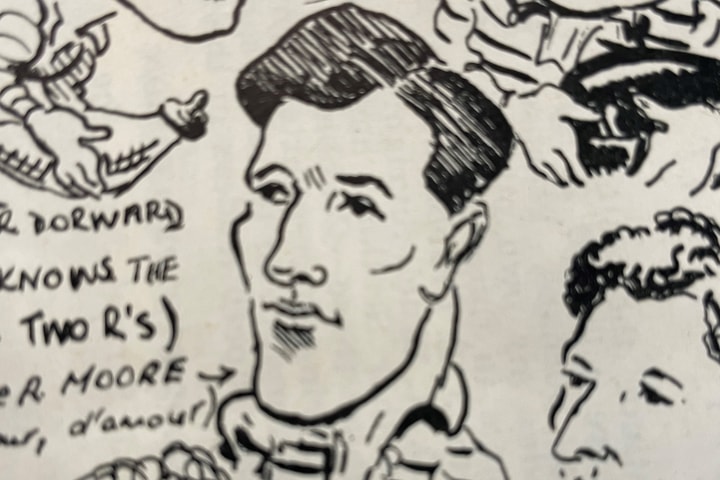
21 November 2025


Two days after the failed attack on Guillemont an open air service took place next to the field guns. The chaplain was Rupert Edward Inglis. Inglis had played for England as a forward in 1886 and had been ordained in 1889. When war broke out he took it upon himself to encourage the local men of his parish to commit themselves to the service of King and country. Then, at the age of 51, he himself had enlisted with the King's Shropshire Light Infantry 1st Battalion. In a letter to his parishioners in July of 1915 he gave his reasons:
'I have felt that in this great crisis in our nation's history, everyone ought to do what he can to help. I have said this both publicly and privately, but it has been hard to tell people that they ought to leave their homes, to go out into strange new surroundings, to endure discomforts and danger - perhaps to face death - it was hard to tell people that this was their duty and then to remain comfortably at home myself.'
As an army chaplain Inglis would be kept busy on the western front, performing field services, administering to the spiritual needs of the men and, when called upon, reading them their last rites. He had spent the tail end of 1915 working in the casualty clearing stations. Primitive and basic in their medical provision the stations were little more than temporary field positions that moved forwards and backwards with the front line. His detailed memoirs, published in 1920, reveal a strong but gentle man, frequently distressed by what he witnessed but always on hand to assist. His wife's home-made cakes (and his whiskey) which he shared amongst them, made him popular with privates and colonels alike. He had noted the arrival of the first swallows during the 1916 spring and the cuckoos, that so reminded him of his home in Kent. He had been removed from the front in advance of the first day of the Somme, but as the battle wore on found himself drawn closer and closer to the fighting. Unsurprisingly he had been adopted as a talisman by his men, who called him 'The Rector' and went so far as to name a trench after him. The constant stream of wounded men kept Inglis the army chaplain busy and by mid-September his clearing station had pushed past Guillemont and into the crater of a German mine on the outskirts of Ginchy. Here the front-line was constantly shifting. Gains were hard won and German counter-attacks perennially threatened to overrun their position. On the 17th September owing to a lack of men, Inglis was put in charge of a company of stretcher bearers. The 6th Division, to whom he was attached, had been held up at the Quadrilateral Redoubt in their efforts to reach Guedecourt, and a growing number of men lay wounded on the battlefield. Colonel Murray of the King's Shropshire's Light Infantry had made a point of asking Inglis to remain at the station but as fewer and fewer stretcher bearers returned the Rector's instinct to help got the better of him. The next day he and a handful of others went over the top to retrieve wounded men from the battlefield. He was first hit in the leg and took shelter in a nearby crater. German artillery had caught sight of him and his co-bearer. A second shell, this time a direct hit, killed them both. Inglis was 53. Dozens of men wrote to his widow to let her know of their fondness for the Rector, one describing him as 'a man in a million'. He is thought to have personally saved many lives by his decision to go and retrieve the wounded and had been recommended for a Military Cross (MC).

Rupert Inglis the Player Born in London in 1863 Rupert Edward Inglis was the youngest son of Sir John Inglis, known as the 'Defender of Lucknow' for his role in the Indian Rebellion of 1857. Rupert attended Rugby School, University College, Oxford and then Ely Theological College before being ordained. Conforming to the Rugby School blueprint for 'muscular Christians', Inglis earned rugby blues in 1883 and 1884, winning both matches comfortably and scoring a try in the second. The contributions of the tall, solidly built Inglis did not go unnoticed by the 1883 Cambridge captain Charles Marriot, who in 1886 would captain England during Inglis' international debut. Inglis was 51 when war broke out and so the players he shared a field with are of a markedly different vintage to those with whom he served. His first cap, a victory against Wales at Rectory Field, where he often turned out for Blackheath, was played in the company of such luminaries as prototype fly-half Alan Rotherham, Charles Gurdon and the dashing threequarter Andrew 'Drewy' Stoddart. In his second game he helped England to victory over Ireland and in his third and final game he helped England avoid defeat and thus retain the Calcutta Cup, at the time still a relatively new invention. England and Scotland shared the spoils and Inglis retired without having tasted defeat. By 1900 Inglis was rector at Frittenden in Kent. He married Helen that year and the couple had three children, Joan, John and Margaret. Beloved of many, Rupert Inglis' name is memorialised in more places than any other English player to have fallen in the Great War. These include the Thiepval Memorial, Twickenham Stadium, Rugby School, MCC at Lord's, Blackheath FC, University College at Oxford, Oxford University RFC, All Saints at Aldershot and churches in Leicestershire , Basingstoke and Frittenden.

About the Author - This article is an extract from the book 'Doing Their Duty: How England's Rugby Players Helped Win the First World War'. Phil McGowan has been a member of the World Rugby Museum team since 2007.
Follow the World Rugby Museum on Facebook, Twitter and Instagram.